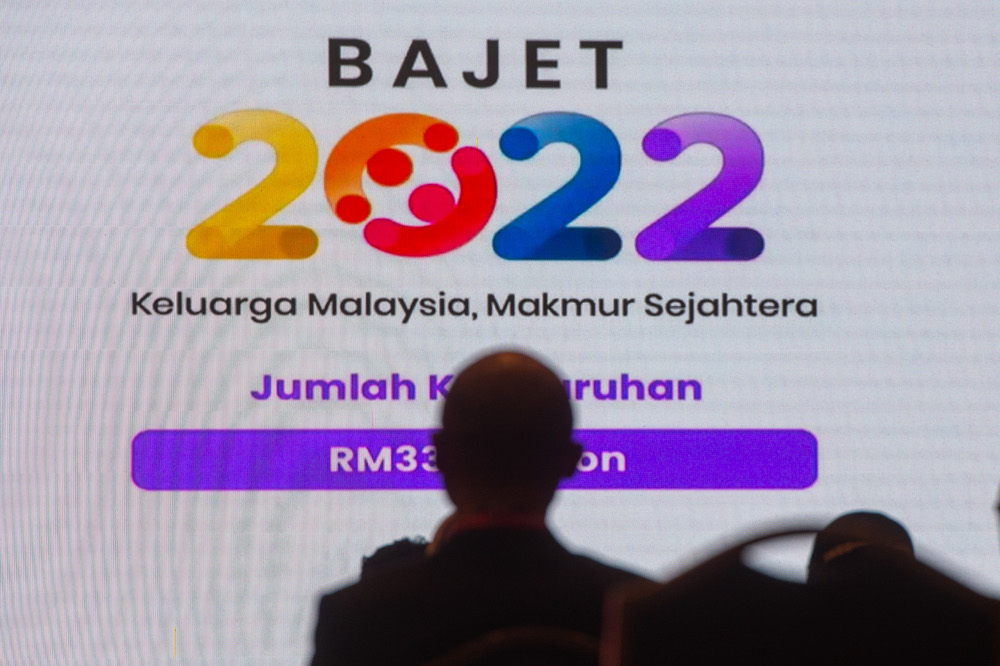KUALA LUMPUR, Oct 31 — Budget 2022 saw a mammoth RM332.1 billion allocated for operational and development expenditure for the coming year, the most in Malaysia’s history.
Its focus is on three major thrusts: Economic recovery, building resilience and stimulating growth as Covid-19 transitions from a pandemic to an endemic disease.
The following is an outline of the main areas Budget 2022 will be funding.
Education
For 2022, the Ministry of Education will receive the lion’s share of RM52.6 billion or 16 per cent of the total federal budget.
Another RM14.5 billion has also been earmarked for the Ministry of Higher Education, making education the largest government expenditure for the coming year, at RM67.1 billion.
Under the Ministry of Education, the government announced an increase to the early school aid of RM150, up from RM50 previously. It allocated RM450 million to help some three million students.
The allocation will also include RM1 billion for the upkeep of some 10,000 schools under the government’s care. This includes some RM140 million to the Malaysian Islamic Development Department (Jakim) to maintain tahfiz and religious schools, or RM40 million more than this year.
Some RM746 million was also allocated to repair dilapidated schools, primarily the 112 in Sabah and 165 in Sarawak classified to be in such a condition.
The government also allocated RM50 million for special education, specifically to purchase teaching tools and upgrade facilities.
Another RM400 million was also allocated to supply milk daily to schools.
The government also introduced a RM100 subsidy for each teacher to buy gadgets for online learning, which will benefit some 400,000 teachers nationwide.
For National Higher Education Fund Corporation (PTPTN) borrowers, the government has offered discounts for full and half settlements as well as scheduled repayments.
Health
The ongoing pandemic meant it was no surprise that the Ministry of Health (MOH) would receive the second highest allocation of any single ministry.
For 2022, MOH will get RM32.4 billion for operational and development costs, with another RM4 billion specifically to combat Covid-19.
The Covid-19 expenditure will also include procurement of booster vaccine doses, antiviral medication and other medical supplies such as personal protective equipment.
The government also agreed to allocate RM100 million to sponsor medical specialist programmes that will benefit some 3,000 medical and dental contract doctors.
An additional RM70 million is also allocated to mental health programmes and advocacy.
Defence and security
To ensure public order and a strong national defence, the Home Ministry and the Defence Ministry will receive RM17 billion and RM16 billion, respectively.
This includes RM1.6 billion to upgrade military assets, including RM14 million for equipment such as parachutes, closed-circuit diving equipment and boats for the navy’s PASKAL and the air force’s PASKAU special forces.
Another RM230 million was also set aside for maintenance work for schools in army camps, military facilities and armed forces personnel homes. This allocation also includes servicing lifts at police quarters.
The government also planned eight new General Operations Force facilities in Pagalungan, Sabah and Temong Mura in Sarawak to enhance border control as well as four new immigration checkpoints in Telok Melano and Baleh, Sarawak to accommodate increased traffic to Kalimantan Indonesia and the opening of the Telok Melano route of the Pan Borneo highway
Some RM100 million was allocated to the National Disaster Management Agency and another RM20 million is budgeted for the Registrar of Societies for the Malaysian Incentive Community Empowerment scheme.
Economic Financing package
To expedite and spur economic growth, the federal government has allocated RM40 billion for various financing schemes under the SemarakNiaga programme for micro, small and medium enterprises (MSMEs) to jump-start their business.
This includes RM14.1 billion being made available for small and medium enterprises including RM2 billion under Bank Negara Malaysia’s Targeted Relief and Recovery Facility to ensure the continuity of businesses.
Other measures also include six-month interest-free loans of up to RM75,000 from Agrobank and BSN and a similar scheme under TEKUN of loans up to RM10,000 with a moratorium of up to a year for micro-businesses.
Another RM2.1 billion is also allocated to help companies having issues of gearing or leverage through equity and quasi-equity investments.
Subsidies, aid and incentives
Overall, the federal budget has set aside RM31 billion specifically for subsidies, aid and incentives in Budget 2022, with the aim of alleviating living costs for Malaysians.
This includes the RM8.2 billion allocated under the new direct cash aid incentives dubbed the Bantuan Keluarga Malaysia benefitting some 9.6 million recipients.
Some RM274 million was also allocated to the Orang Asli community, including school aid and welfare subsidies that aim to help some 200,000 individuals.
Other initiatives include RM200 million to cover the cost of transportation and distribution of general goods to rural areas.
The aid and subsidies also ensure regions such as Sabah and Sarawak will continue to have affordable access to liquefied petroleum gas (LPG) and petrol.
Enhancing the Bumiputera community and strengthening Islam
The federal government also allocated RM11.4 billion to empower the Bumiputera community and Islam for 2022.
This included RM6.6 billion to provide education access to Bumiputera students under MARA, UiTM dan Yayasan Peneraju.
Another RM4.8 billion will also be disbursed through financing facilities under the Perbadanan Usahawan Nasional Berhad, TEKUN Nasional and Dana Kemakmuran Bumiputera.
The government also set aside RM200 million to encourage Bumiputera youths to take up small-scale federal projects.
The government also allocated RM1.5 billion for Islamic Affairs under the Prime Minister’s Department for development and expenditure.
This includes building a religious secondary school in Labuan at the cost of RM65 million, recruiting some 1,000 educators under Jakim, and providing a one-off payment of RM500 each to around 70,000 religious figures and teachers.



















